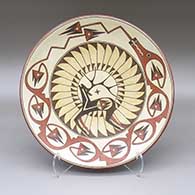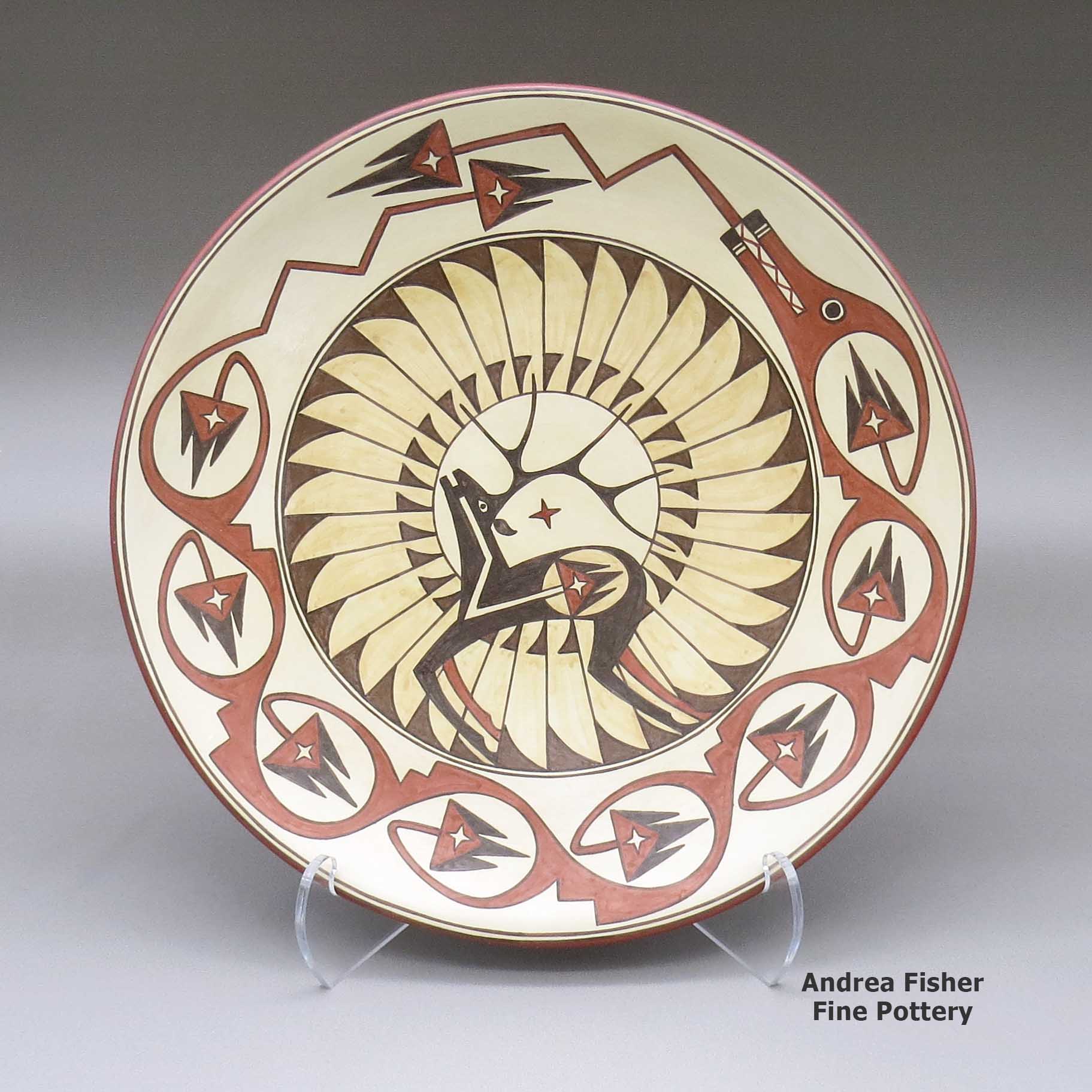
Lois Gutierrez
de la Cruz
Santa Clara
Born in 1948, Lois Gutierrez is the sister of Gloria (Goldenrod) Garcia, Thelma Talachy and Minnie Vigil. They all learned the ancient art from their mother, Petra Montoya Gutierrez, as they were growing up. Petra was from Pojoaque Pueblo and had married into Santa Clara. Her daughters were raised using mostly Santa Clara clays and designs.
Lois married Derek de la Cruz many years ago and they've been working together since: Lois does most of the potting and painting while Derek works with the clay and helps with the firing. Lois and Derek are among the few potters still working at Santa Clara who are willing to search out and prepare the various colors of natural clay Lois uses on her pots. One of their collaborations won the Best of Show ribbon at the Santa Fe Indian Market in 1982 and they were so overwhelmed by the sudden increased demand for their pottery they never exhibited there again, often choosing to go to the New Mexico State Fair instead (and they've won more than a few ribbons there, too).
Lois's specialty is polychrome pottery made the way it used to be at Santa Clara, before the carving and sgraffito processes took hold. Her designs are often depictions of scenes from pueblo life, adorned with appropriate geometrics.
Some Exhibits that Featured Works by Lois and Derek
- Artistic Excellence: The Heard Museum Guild Indian Fair & Market Celebrates 60 Years. Heard Museum. Phoenix, Arizona. February 2, 2018 - August 31, 2018
- Images, Artists, Styles: Recent Acquisitions from the Heard Museum Collection. Heard Museum North. Scottsdale, Arizona. July 2001 - July 2002
- 1980 Heard Museum Guild Indian Arts and Crafts Exhibit. Heard Museum. Phoenix, Arizona. November 26 - December 3, 1980 Rising Stars. Gallery 10. Scottsdale, Arizona. February 8-27, 1980
- 1978 Heard Museum Guild Indian Arts and Crafts Exhibit. Heard Museum. Phoenix, Arizona. November 24 - December 2, 1978
- 1977 Heard Museum Guild Indian Arts and Crafts Exhibit. Heard Museum. Phoenix, Arizona. November 25 - December 3, 1977
- 1976 Heard Museum Guild Indian Arts and Crafts Exhibit. Heard Museum. Phoenix, Arizona. November 26 - December 5, 1976
Some Awards Won by Lois and Derek
- 1984 Santa Fe Indian Market, Classification II - Pottery, Division E - Traditional pottery, painted designs on burnished black or red surface, Category 1102 - Jars (over 8 inches tall): Second Place
- 1983 Santa Fe Indian Market, Katherine and Miguel Otero Award - Creative excellence in any category
- 1983 Santa Fe Indian Market, Classification II - Pottery, Division F - Traditional, painted designs on matte or semi-matte surface: Second Place
- 1982 Santa Fe Indian Market. Best of Show
- 1982 Santa Fe Indian Market, Best of Class - Pottery
- 1982 Santa Fe Indian Market, Classification Pottery, Best of Division
- 1982 Santa Fe Indian Market, Classification Pottery, Traditional Hopi, Zia, Acoma Style Pottery. Jars - Other Pueblos: First Place
- 1980 Heard Museum Guild Indian Arts and Crafts Exhibit, Classification VII, Pottery, Division A - Traditional construction and firing: Honorable Mention. Awarded for artwork: Large vase with fluted rim
- 1978 Heard Museum Guild Indian Arts and Crafts Exhibit, Best of Show. Awarded for polychrome bowl: "Hunter & Turkey"
- 1978 Heard Museum Guild Indian Arts and Crafts Exhibit: Heard Museum Board of Trustees Best of Crafts. Awarded for polychrome bowl: "Hunter & Turkey"
- 1978 Heard Museum Guild Indian Arts and Crafts Exhibit, Best of Pottery. Awarded for polychrome bowl: "Hunter & Turkey"
- 1978 Heard Museum Guild Indian Arts and Crafts Exhibit, Best of New Mexico Pueblo Pottery. Awarded for polychrome bowl: "Hunter & Turkey"
- 1978 Heard Museum Guild Indian Arts and Crafts Exhibit, Classification VII - Pottery, Division B - Contemporary: First Place. Awarded for polychrome bowl: "Hunter & Turkey"
- 1977 Heard Museum Guild Indian Arts and Crafts Exhibit, Classification VII - Pottery, Division B - Contemporary: Second Place. Awarded for artwork polychrome bowl
- 1976 Heard Museum Guild Indian Arts and Crafts Exhibit, Classification X - Pottery, Division B - Contemporary: Honorable Mention. Awarded for artwork: White bowl with rain dance design
100 West San Francisco Street, Santa Fe, New Mexico 87501
(505) 986-1234 - www.andreafisherpottery.com - All Rights Reserved

Santa Clara Pueblo

Ruins at Puye Cliffs, Santa Clara Pueblo
Santa Clara Pueblo straddles the Rio Grande about 25 miles north of Santa Fe. Of all the pueblos, Santa Clara has the largest number of potters.
The ancestral roots of the Santa Clara people have been traced to the pueblos in the Mesa Verde region in southwestern Colorado. When that area began to get dry between about 1100 and 1300, some of the people migrated to the Chama River Valley and constructed Poshuouinge (about 3 miles south of what is now Abiquiu on the edge of the mesa above the Chama River). Eventually reaching two and three stories high with up to 700 rooms on the ground floor, Poshuouinge was inhabited from about 1375 to about 1475. Drought then again forced the people to move, some of them going to the area of Puye (on the eastern slopes of the Pajarito Plateau of the Jemez Mountains) and others to Ohkay Owingeh (San Juan Pueblo, along the Rio Grande). Beginning around 1580, drought forced the residents of the Puye area to relocate closer to the Rio Grande and they founded what we now know as Santa Clara Pueblo on the west bank of the river, between San Juan and San Ildefonso Pueblos.
In 1598 Spanish colonists from nearby Yunque (the seat of Spanish government near San Juan Pueblo) brought the first missionaries to Santa Clara. That led to the first mission church being built around 1622. However, the Santa Clarans chafed under the weight of Spanish rule like the other pueblos did and were in the forefront of the Pueblo Revolt of 1680. One pueblo resident, a mixed black and Tewa man named Domingo Naranjo, was one of the rebellion's ringleaders. When Don Diego de Vargas came back to the area in 1694, he found most of the Santa Clarans on top of nearby Black Mesa (with the people of San Ildefonso). An extended siege didn't subdue them so eventually, the two sides negotiated a treaty and the people returned to their pueblo. However, successive invasions and occupations by northern Europeans took their toll on the tribe over the next 250 years. The Spanish flu pandemic in 1918 almost wiped them out.
Today, Santa Clara Pueblo is home to as many as 2,600 people and they comprise probably the largest per capita number of artists of any North American tribe (estimates of the number of potters run as high as 1-in-4 residents).
Today's pottery from Santa Clara is typically either black or red. It is usually highly polished and designs might be deeply carved or etched ("sgraffito") into the pot's surface. The water serpent, ("avanyu"), is a traditional design motif of Santa Clara pottery. Another motif comes from the legend that a bear helped the people find water during a drought. The bear paw has appeared on their pottery ever since.
One of the reasons for the distinction this pueblo has received is because of the evolving artistry the potters have brought to the craft. Not only did this pueblo produce excellent black and redware, several notable innovations helped move pottery from the realm of utilitarian vessels into the domain of art. Different styles of polychrome redware emerged in the 1920's-1930's. In the early 1960's experiments with stone inlay, incising and double firing began. Modern potters have also extended the tradition with unusual shapes, slips and designs, illustrating what one Santa Clara potter said: "At Santa Clara, being non-traditional is the tradition." (This refers strictly to artistic expression; the method of creating pottery remains traditional).
Santa Clara Pueblo is home to a number of famous pottery families: Tafoya, Baca, Gutierrez, Naranjo, Suazo, Chavarria, Garcia, Vigil, Tapia - to name a few.
100 West San Francisco Street, Santa Fe, New Mexico 87501
(505) 986-1234 - www.andreafisherpottery.com - All Rights Reserved


Lois Gutierrez, Santa_Clara, Polychromeplatewithapaintedavanyu,deer-with-heart-line,andfeatherringgeometricdesign
Santa Clara
$ 1500
josc3k226
Polychrome plate with a painted avanyu, deer-with-heart-line, and feather ring geometric design
11.75 in L by 11.75 in W by 1.75 in H
Condition: Very good, has rubbing on bottom and around edge
Signature: -Lois-, with cross hallmark, copyright symbol, and date
Date Created: 2007
100 West San Francisco Street, Santa Fe, New Mexico 87501
(505) 986-1234 - www.andreafisherpottery.com - All Rights Reserved

Pasqualita Tani Gutierrez Family Tree
Disclaimer: This "family tree" is a best effort on our part to determine who the potters are in this family and arrange them in a generational order. The general information available is questionable so we have tried to show each of these diagrams to living members of each family to get their input and approval, too. This diagram is subject to change should we get better info.
Pasqualita Tani Gutierrez was the sister of Sarafina Tafoya.
- Pasqualita Tani Gutierrez (1883-) & Severiano Tafoya
- Petra Montoya (Pojoaque)(1905-) & Juan Isidro Gutierrez (Santa Clara, 1901-1977)
- Gloria Goldenrod Garcia & John Garcia
- Jason Okuu Pin Garcia
- Desiderio Star Gutierrez & Genevieve Tafoya
- Debra Duwyenie & Preston Duwyenie (Hopi)
- Lois Gutierrez (1948-) & Derek de la Cruz
- Juan de la Cruz
- Thelma (1946-) & Joe (1940-) Talachy (San Juan)
- Maria Minnie Vigil (1931-)
- Annette Vigil
- Virginia Gutierrez (daughter-in-law of Petra, Nambe/Pojoaque)(1940-2012)
- Gloria Goldenrod Garcia & John Garcia
- Tomacita Gutierrez Tafoya (1896-1977) & Cruz Tafoya (1889-1938)
- Cresencia Tafoya (1918-1999)
- Annie Baca (1941-)
- Pauline Martinez (1950-) & George Martinez (San Ildefonso) (1943-)
- Harriet Tafoya (1949-) & Elmer Red Starr (Sioux) (1937-)
- Ivan Red Starr (1969-1991)
- Norman Red Star (nephew) (1955-)
- Cresencia Tafoya (1918-1999)
- Celestina Naranjo & Salvador Naranjo
Some of the above info is drawn from Pueblo Indian Pottery, 750 Artist Biographies, by Gregory Schaaf, © 2000, Center for Indigenous Arts & Studies. Other info is derived from personal contacts with family members and through interminable searches of the Internet.
(505) 986-1234 - www.andreafisherpottery.com - All Rights Reserved




